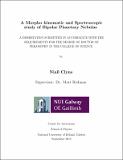| dc.description.abstract | In this thesis, studies of the kinematic properties for a sample of Galactic bipolar planetary nebulae, based on optical and infrared observations, were performed us- ing a morpho–kinematic code, optical and NIR diagnostic diagrams, and techniques using data analyses. The mechanisms that form complex bipolar planetary nebulae remain unclear, and their shapes can be generated either as a planetary or symbiotic nebula. The origin of the material ionised by the white dwarf is very different in these two scenarios, and it complicates the understanding of the morphologies of planetary nebulae. The physical properties, structure, and dynamics of the bipolar nebulae, MyCn 18, M 2–9, Mz 3, Hen 2–104, and Abell 14, are each investigated in detail with the aim of understanding their nature, shaping mechanisms, and evolutionry history. For MyCn 18, VLT infrared images, VLT ISAAC infrared spectra, and long– slit optical echelle spectra are used to investigate the inner and outer regions of the nebula. The morpho–kinematic modelling tool shape was used to firmly constrain the structure and kinematics of the source. For M 2–9, Mz 3, and Hen 2–104, long– slit optical echelle spectra were used to investigate their morpho–kinematics using shape. Near–infrared data, as well as optical spectra, were used to separate Galac- tic symbiotic–type nebulae from genuine planetary nebulae, which included M 2–9, Mz 3, Hen 2–104, and MyCn 18, by means of a 2MASS J–H/H–Ks diagram and a λ4363/Hγ vs. λ5007/Hβ diagnostic diagram, respectively. For Abell 14, a detailed study of its 3-D morphology and kinematics were performed using shape. The overall conclusion is that, for each object, the kinematics, morphology, nebular evolution, and their nature, are better understood by means of morpho–kinematic and spectroscopic analyses. | en_IE |


